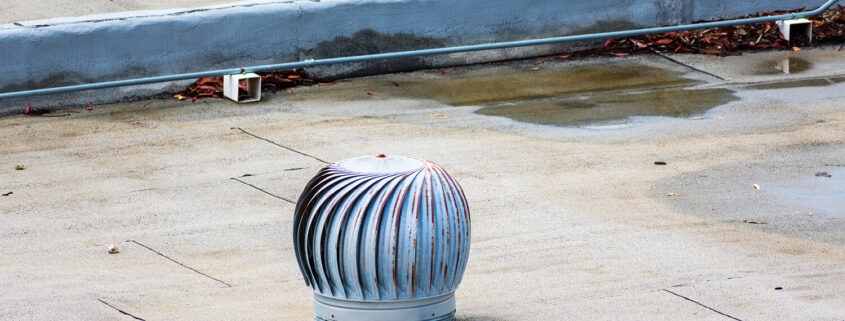Not many business owners understand the true importance of proper roof ventilation – after all, it’s not your area of expertise. An often overlooked part of a commercial building is the airflow in the attic. Hot, moist air can cause costly issues, but we’re here to help.
Your commercial building’s roof ventilation system needs to be the RIGHT one. When installing a new roof, the ventilation system must be accounted for to ensure that it can achieve maximum efficiency.
Different types of roof vents are better suited for certain commercial roofs. If you want to avoid issues caused by poor ventilation, then you need to know which one is best for your roof.
The Importance of Proper Roof Ventilation
Before breaking down the different types of vent systems, it is helpful to understand why they’re so important. Ventilation is a major key to preventing roofing issues that affect overall lifespan.
Prevent Moisture Accumulation
Accumulating moisture on your roof causes damage when not properly addressed; warm air results in rot, mildew, or warping in your roof (which can also lead to leaks or other damage to the roofing materials).
Moisture accumulation can lead to mold buildup, too, which is not only hazardous to your building’s materials but also to your health. Getting rid of mold in your building can be a long and costly process, and it’s best to avoid it entirely by allowing for proper airflow.
Mitigate Ice Dams
During the winter, improper ventilation can lead to ice dams on your roof. When heat from your attic melts accumulated snow on the roof, the water refreezes in the eaves and blocks water from flowing off the roof.
Ice dams lead to water damage and significantly reduce your roof’s lifespan. To avoid this, air circulation is key, ensuring that hot air won’t melt ice on the roof.
Lower Energy Costs
If your roof is not properly ventilated, the hot air in your attic causes the temperature of your entire building to rise, meaning that your air conditioning system works harder and for longer periods (which leads to significantly higher energy bills).
When your roof is properly ventilated, your attic has cooler air. This makes your building more energy-efficient and eco-friendly, and will save you money, too!
Types of Commercial Roof Vents
Attic ventilation is a must, and different buildings (and roofs) require different types of roof vents. Intake vents and exhaust vents work better for some buildings and climates. Because of this, it is important to be familiar with multiple common types of roof vents.
The two main categories of ventilation systems are active and passive.
Passive ventilation uses naturally occurring convection currents to release hot, stale air and pull in cool, fresh air. These can be slightly less efficient, but are cheaper since the only components are the vents for cool air intake and exhaust. Passive ventilation systems are typically used by homeowners for residential homes and include soffit vents, eave vents, cupola vents, gable vents, and ridge vents hidden in the ridge line of pitched roofs.
Commercial buildings are more likely to depend on active ventilation systems due to their size. Active ventilation uses power vents to facilitate air flow. These systems are more effective but more costly because they have more moving parts.
There are also mixed modes of ventilation, where commercial buildings use power vents along with passive ventilation system elements.
Whirlybird/Turbine Vents
A wind-powered ventilation system is shaped like a bulb or dome. It pulls air into the Whirlybirds, resulting in a low-cost option that cools the building and expels excess moisture. However, it needs wind for power, so it’s best used with an active ventilation system. Low-wind zones may need to take other options into consideration.
Static Vents
Static vents are a type of exhaust vent used in passive ventilation systems. These vents, also known as box vents, are placed near the roofline and allow hot air to escape. Passive vents are a low-cost option and work great for smaller commercial buildings.
Louver Vents
Louver vents are part of an HVAC system that is installed in exterior walls and on the roof of a commercial building. They have angled blades in a metal frame that direct air flow. The blades can either be in a fixed position or adjustable. They’re a low profile option, and can even enhance the aesthetics of your commercial building as they come in various styles.
Which Commercial Roof Vent is Best For You?
Depending on many factors, the best attic ventilation system for your building varies. There are several other types of vents not covered in this blog, such as solar-powered vents, turtle vents, drip edge vents, fascia vents, off-ridge vents, roof turbines, etc. – all have situations in which they are more effective than their counterparts. Speak with a commercial roofing contractor who can lead you down the right path!
If you don’t know where to start when it comes to the best type of roof vent, we’re here for you.
You don’t need to worry about a thing when you have a roofing company like TEMA Roofing Services by your side. Our services are comprehensive: roof installation, 24-hour emergency repair, cooperative purchasing, and much more. Contact us today to get a quote!





